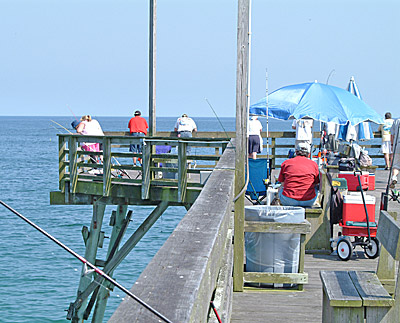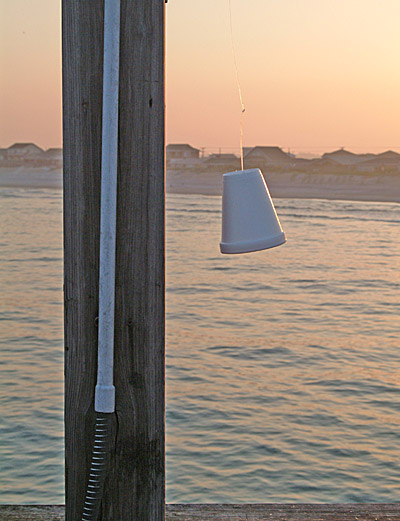|
|
Jolly Roger Oceanfront Motel & Pier
|
 When most people think of fishing on the Jolly Roger Pier in Topsail Beach, NC, they think of the fall fishing season. They think of the September finger mullet runs, the leaping king mackerel, the massive schools of spots in October, and the many other abundant species of fish that move through our waters that time of year; and for good reason. But what most people overlook is the incredible fishing during the spring to early summer months (Mid March to Mid June). From the time in March when the water temperature reaches approximately 60 degrees, until late June when the water reaches the summer temperature levels, there are fantastic fishing opportunities on the Jolly Roger Pier, and a smorgasbord of species are represented.
When most people think of fishing on the Jolly Roger Pier in Topsail Beach, NC, they think of the fall fishing season. They think of the September finger mullet runs, the leaping king mackerel, the massive schools of spots in October, and the many other abundant species of fish that move through our waters that time of year; and for good reason. But what most people overlook is the incredible fishing during the spring to early summer months (Mid March to Mid June). From the time in March when the water temperature reaches approximately 60 degrees, until late June when the water reaches the summer temperature levels, there are fantastic fishing opportunities on the Jolly Roger Pier, and a smorgasbord of species are represented.
It all begins around the middle of March. This is when the first Virginia mullet, or whiting as some call them, begin to move into our waters. These bottom feeders can be caught on shrimp, (fresh is best) or on artificial shrimp and clams. The best time to fish for mullet is at night; a South or Southwest wind is preferable. Virginia mullet also happen to be one of the best eating fish that we catch. The spring run of mullet normally lasts well into April before gradually fading as the water warms. Black drum show up right about the same time as the mullet, and can be caught on the same baits. They are also a very good eating fish, and put up an excellent fight when hooked. Black drum will stay around the pier throughout the spring and into the summer months.
The next major species of fish to move in is the bluefish. Hungry and aggressive from a lack of food during the winter, they show up around the end of March, ready and willing to bite almost anything in front of them. There are few fish that will put up as much fight, pound for pound, as the bluefish. Although not quite as good on the table as the mullet, they aren’t bad if cooked fresh, and offer many exciting early season angling opportunities. The first blues to show range in size from 1-3 pounds, but beginning around the 15th of April, the bigger chopper blues begin to arrive. These fish normally range in sizes from 5-20 lbs, and are an absolute blast on light tackle jigging gear! Both the school size blues and the chopper blues can be caught on bottom rigs with cut bait or with artificial lures such as the gotcha-plug.

Around the first of April, we start to see the puppy drum and flounder become more active as well. Although they stay in our waters year round, they do not feed as much during the winter months because the cold water slows their metabolism. Once the water temperature hits that 58-60 degree mark, a dramatic increase in feeding activity can be observed with the drum and flounder. Both of these fish can be caught on artificial baits such as Berkly Gulp or bucktails, and on natural presentations like fresh cut bait. Live minnows and shrimp are another good bait choice for these fish, but these baits can sometimes be difficult to find during the early spring months.
As we move later into April and the water reaches the mid to upper 60’s, we observe an overall change in the ocean life.. Baitfish such as the glass minnow become prevalent, and jelly balls can be seen floating along with the currents. It is normally near the 25th of April when the first Spanish mackerel of the year is landed. Spanish mackerel and spring fishing on the Jolly Roger Pier go hand in hand; one can hardly be mentioned without the other. People travel from far and wide for a chance to land a few of these exciting and tasty fish. The Spanish show up in late April, and remain in good numbers through mid June. These fish range in size from 1-5 pounds, and are caught on artificial lures such as the gotcha-plug, clarkspoon, and diamond jig. Early morning and late afternoon are the best times to fish for Spanish, and reasonably clear water is normally a plus. The best runs normally occur when the wind is anywhere from SE to SW, at 0-20 mph.
This brings us to May, the pinnacle of our spring fishing season. May is to the spring what October is to the fall, a collaboration of all the species! In addition to all of the species listed above, we see many of our warmer water fish such as the cobia, king mackerel, pompano, and sheepshead, begin to arrive from their southern wintering areas. It is around the first of May that the “king” fishermen”begin to try their luck on the end of the pier. Cobia, also called saltwater catfish, can be found in our waters as early as the 20th of April, and the first king is normally landed in early to mid May.
 This is a unique fishery: it provides one the few chances of landing some of the offshore species of fish without having to use a boat. The cobia will test even the best fishing gear, and it’s one of the most enduring fighters in the ocean; some cobia have fought for over 3 hours before being landed on the pier! The king mackerel, on the other hand, is know for it’s electrifying strikes (sometimes leaping 15’ in the air on the strike) and the blazing fast runs it makes during the fight. Both of these fish are caught on live baits such as bluefish, menhaden, and grass shad.
This is a unique fishery: it provides one the few chances of landing some of the offshore species of fish without having to use a boat. The cobia will test even the best fishing gear, and it’s one of the most enduring fighters in the ocean; some cobia have fought for over 3 hours before being landed on the pier! The king mackerel, on the other hand, is know for it’s electrifying strikes (sometimes leaping 15’ in the air on the strike) and the blazing fast runs it makes during the fight. Both of these fish are caught on live baits such as bluefish, menhaden, and grass shad.
So although the spring season not as well recognized as the fall fishing season here on Topsail Island, it is not because of the lack of a fishery. The spring fishing season can be just as good if not better than any other time of the year, minus the crowds! As with all fishing the exact timing when each of the specific fish species will move in depends heavily on the weather conditions each year. Whether a little early or a little late, the fact remains that there is hardly a better way to shake off the grips of winter, than by grabbing a rod and heading to the Jolly Roger Pier for a day on the planks with the chance at many, many species of fish, and hopefully, full coolers and fish stories to tell for winters to come. Let's go fishing! — Rob Orr